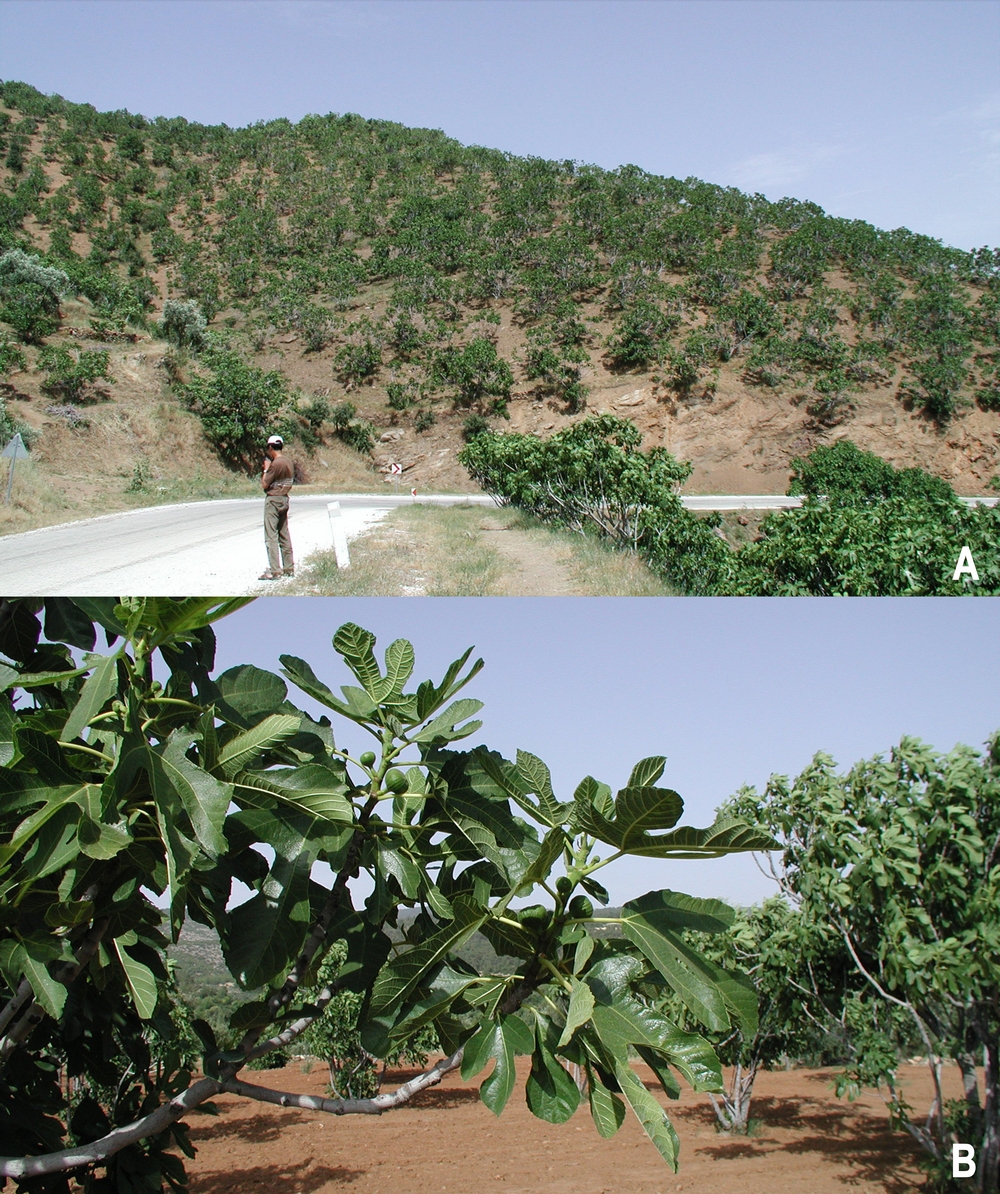 |
Ficus carica Linnaeus
Cultivated Fig
|
|
|

Figure 1.
Ficus carica. A. Wild F. carica on the rocky bank of
river Hérault, March 2020, St-Guilhem-le-désert, France © F.
Kjellberg. B. Wild F. carica male in fields, July , Malemort,
France; at that period, there are no receptive figs on male trees,
the wasps can only go from male figs to figs on female trees © J.-Y.
Rasplus.
|
|

Figure 2.
Ficus carica. A. Wild F. carica female tree with ripe
seed-containing figs, © F. Kjellberg. B. Wild F. carica male,
polliniferous figs at the stage of
Blastophaga psenes emergence, © J.-Y. Rasplus.
|
|

Figure 3.
A. Ficus carica (typical form), on rocks along river banks.
B. F. carica (form Ficus colchica Grossh.), this is
morphologically the most divergent form of F. carica with
gracile branches and flexible leaves, Black Sea coast, Turkey. C.
Ficus palmata, Adiyaman Province, Turkey; F. palmata is
distributed from Ethiopia to India and Nepal, and is the sole
species closely related to F. carica. D. F. palmata
male tree with profichi. All photos © F. Kjellberg. |
|

Figure 4.
Ficus carica. A. Female tree, receptive fig; the elongate
stigmas that will brush the body of the wasp, collecting pollen and
ensuring seed set. B. Detail of the elongate stigmas with papillae
on which pollen will stick, the styles are long and does not allow
wasp oviposition. C. Male tree, inside a receptive fig the styles
are short allowing wasp oviposition male tree. D. Fig a few days
after oviposition; immature male flowers are visible in the upper
part of the fig; in the lower part, female flowers show style with
brown trace of ovipositor insertion, the pedicel elongates and the
ovule begins to swell turning into a gall. All photos © F. Kjellberg. |
|

Figure 5.
A. Fig plantation, Meander valley, Turkey. B. female tree, receptive
figs of the second crop (= the crop present on wild female trees),
requiring pollination; this phenotype is very similar to typical
wild female trees, same locality. All photos © F. Kjellberg. |
|
|

|
 |
|
 |
Cultivated fig South
Africa (photographs © Simon van Noort (Iziko Museums of South Africa). |
|
Biology
|
 Pollinator:
Blastophaga psenes (Linnaeus,
1758).
Pollinator:
Blastophaga psenes (Linnaeus,
1758).
|

Non-pollinator (parasitoid of pollinator):
Philotrypesis caricae
(Linnaeus, 1762) |
Distribution
|
Palaearctic
region; introduced to Afrotropical, Australasian, Nearctic, and Oriental
regions. |
Links
|
Ficus carica and its pollination (Kjellberg & Lesne
2020).
Purdue University's
NewCrop site (For information on
varieties, cultivation and uses).
The
Calimyrna fig and its pollinator wasp (Armstrong, 2010).
Do we eat fig wasps when we
consume cultivated figs? |
Comments
|
Very closely related to
Ficus
palmata.
|
References
|
Armstrong, W.P. 1988.
The calimyrna fig and its wasp. California Garden 79,
135-138.
Armstrong, W.P. 2010. Calimyrna Figs in California.
Available at:
https://www2.palomar.edu/users/warmstrong/pljune99.htm
Gaaliche, B. Trad, M. Mars, M. 2011.
Effect of pollination intensity, frequency and pollen source on fig (Ficus carica L.) productivity and fruit quality.
Scientia Horticulturae
130 (4): 737-742.
Giliomee JH, Venter E, Wohlfarter M. 2007.
Mediterranean black fig fly, Silba adipata McAlpine (Diptera:
Lonchaeidae), recorded from South Africa. African
Entomology 15: 383-384.
https://doi.org/10.4001/1021-3589-15.2.383
Kjellberg, F. and Lesne A. 2020.
Ficus carica and its pollination.
https://hal.archives-ouvertes.fr/hal-02516888
Kjellberg, F. van Noort, S, Rasplus JY. In press. Fig wasp
and pollination. In Sarkhosh, L. Ferguson, A.M. Yavari
(Editors): The Fig: Botany, Production and Uses. CAB
International.
Stover, E., Aradhya, M., Ferguson L. & Crisosto, C.H.
2007. The fig: Overview of an ancient fruit.
HortScience 42:1083–1087.
Tribolet, I. 1912.
Caprification of smyrna figs. Agricultural Journal of the
Union of South Africa 3: 247-256.
Wohlfarter M, Giliomee JH, Venter E, Storey S.
2011.
A survey of the arthropod pests and plant parasitic nematodes
associated with commercial figs, Ficus carica (Moraceae),
in South Africa. African Entomology 19: 165-172.
https://doi.org/10.4001/003.019.0118 |
Credits
|
Photographs
© Finn Kjellberg; or © Jean-Yves Rasplus; or
© Simon
van Noort (Iziko Museums of South Africa).
|
|
Next
species |
Ficus
palmata
Forsskål |
|